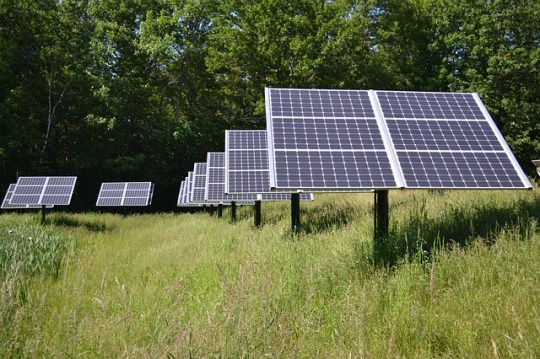Last month, President Obama and the U.S. Environmental Protection Agency (EPA) finalized the Clean Power Plan, the first federal plan to reduce carbon pollution.
The initiative targets power plants and electricity — which account for the majority of greenhouse gas emissions — with individual state plans. These customized goals, to be met by 2030, reflect each state’s existing emission rates from fossil-fuel-fired electric generating units, such as coal plants in Georgia.
Georgia’s emission rate ranks it in the middle among the states. The Peach State’s goal, based on its ranking, is 1,049 pounds per megawatt-hour, which means no more than that amount of carbon dioxide can be produced per each megawatt-hour of electricity generated.
“It’s something we can do, and we can make a difference,” says June Deen, senior vice president of the Georgia chapter of the American Lung Association.
The aim of the Clean Power Plan is to reduce carbon pollution and lessen other harmful pollutants, thereby mitigating the effects of climate change and protecting public health.
But energy issues are often controversial, and climate change is a touchy subject, especially among Republicans. Many GOP leaders oppose the plan. U.S. Sens. Johnny Isakson and David Perdue say they worry that it will increase the costs of electricity and harm the economy.
A matter of worldwide concern
Health experts believe the plan’s benefits — in terms of improved health and ultimately from a financial standpoint — outweigh the initial costs. The EPA says that for every $1 in costs, the plan will provide $7 in health and economic benefits.
The World Health Organization’s International Agency for Research on Cancer determined that outdoor air pollution is a leading environmental cause of cancer deaths.
More than 40 percent of Americans live in areas where it is unsafe to breathe, according to the State of the Air 2015 report by the American Lung Association.
“The closer you look, the more you find” on the health effects of air pollution, says Dr. Eric Honig, a pulmonary disease specialist at Grady Memorial Hospital in Atlanta.
Since 1970, carbon dioxide levels have increased by 24 percent, according to the EPA.
“We used to think the ability of the Earth to absorb all these things was infinite,” says Honig.
Georgia has already taken several small strides toward cleaner energy.
In 2015, Georgia led the nation in clean-energy employment growth, creating about 2,000 jobs at five new solar projects, according to Environmental Entrepreneurs, a group that promotes economically and environmentally sound policies. In 2014, $79 million was invested on solar installations in Georgia, according to the Solar Energy Industries Association.
The Georgia Legislature passed a bill that allows homeowners to sign agreements with solar power companies to allow them to sell electricity generated from the sun back to the local grid.
Solar power will be just one of Georgia’s clean energy options to help the state meet the requirements of the Clean Power Plan, which sets goals but allows states to reach them however they wish. New renewable generating capacity installed after 2012 will count toward helping states meet their goals.
Last year, solar energy did not create a single percentage point of the energy source breakdown of Georgia Power, Georgia’s central electricity company. In 2014, coal accounted for 41 percent of Georgia Power’s fuel, followed by 35 percent gas and oil, 22 percent nuclear and 2 percent hydro power. By these estimates, nuclear energy produces 91 percent of Georgia’s emission-free electricity.
Nuclear energy will figure into how Georgia reaches its goal.
The EPA will allow Georgia’s Southern Nuclear, along with two other nuclear plants in South Carolina and Tennessee, to count 5.5 gigawatts (GW) of electricity from their new nuclear reactors under construction toward their state goals.
The use of nuclear plants now under construction, new solar power, and planned retirements of coal plants represent steps that “may put Georgia in a strong compliance position compared to other states with similar goals,” according to the EPA.
By 2030, Georgia has the potential to generate more than 13 million megawatt-hours from renewable energy sources, according to the National Renewable Energy Laboratory.
Prior to these major changes, Georgia’s capital city had been making strides to reduce pollution for several years.
“We’re working to put Atlanta on the path towards carbon neutrality,” says Jairo Garcia, the sustainability management analyst for the City of Atlanta.
Atlanta adopted a Climate Action Plan, which “reaffirms the city’s recognition of the risk that climate change poses to Atlanta’s citizens,” says Garcia. Atlanta remains among the worst annual particle-polluted cities in the nation, though the city has improved. Since 2013, Atlanta dropped from the list of the top 25 ozone-polluted cities, according to the State of the Air report.
“Progressive cities like Atlanta are leaders,” says Deen. “We can attract cleaner companies.”
Political fight possible
The Sustainability Department of Atlanta created a project targeted toward 10 sustainability initiatives, including air quality.
Small projects, including transportation, urban planning and education, have helped Atlanta clean up its air. In 2014, Atlanta ranked among the top five cities for the most Energy Star-certified buildings, according to the EPA.
Additionally, the Clean Air Campaign helped more than 300 schools in Georgia offer action-based learning projects to reduce air pollution, while educating students on sustainability, air quality, and transportation.
“We look through the same lens on climate action and sustainability,” says Aaron Bastian, the communications and project manager at the Mayor’s Office of Sustainability. Atlanta set goals to reduce greenhouse gas emissions by 25 percent by 2020. Bastian says the city is showing “moderate” results in reaching this goal.
The Clean Power Plan may further encourage Atlanta’s work to reduce harmful emissions.
In 2016, each state must produce a plan to work with the EPA to lessen the carbon load. But on Capitol Hill, opponents of the federal effort have other ideas. The Affordable Reliable Electricity Now Act, proposed in Congress this year, could delay that deadline or otherwise weaken the Clean Power Plan if passed.
Meanwhile, here in Georgia, Gov. Nathan Deal has instructed the Environmental Protection Division to draft a plan to meet the federal requirements as they now exist.
“Congress is another kettle of fish,” comments Deen.
Caroline Eggers, a recent graduate of Emory University, is a Georgia Health News intern.





